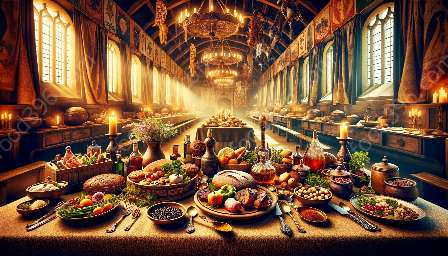Medieval cuisine was a tapestry of diverse culinary traditions, influenced by geography, culture, and available ingredients. From the hearty dishes of Northern Europe to the aromatic flavors of the Mediterranean, regional variations in medieval cuisine played a significant role in shaping the history of food.
The Influence of Geography
Geographical differences in climate, terrain, and access to resources influenced the culinary practices of medieval societies. In Northern Europe, where cold weather and fertile land were prevalent, hearty dishes featuring meat, grains, and root vegetables were popular. In contrast, the Mediterranean region, with its warm climate and proximity to the sea, gave rise to a cuisine characterized by fresh seafood, olive oil, and an abundance of herbs and spices.
Diversity of Ingredients
Regional variations in medieval cuisine were also shaped by the availability of ingredients. In regions with access to certain products, such as wine, spices, or exotic fruits brought by trade routes, the local cuisine was enriched and diversified. For example, the spice trade with the Far East not only influenced the flavors of Mediterranean cuisine but also contributed to the emergence of new cooking techniques.
Cultural Influences
The cultural diversity in medieval Europe, from the Moors in Spain to the Vikings in Scandinavia, left its mark on the culinary landscape. The fusion of different cultural traditions led to the exchange of cooking methods, ingredients, and flavors, resulting in a rich tapestry of regional cuisine.
Evolution of Cooking Techniques
The diverse regional variations in medieval cuisine also influenced the development of cooking techniques. For instance, the use of spices for preservation and flavor enhancement, as seen in the dishes of the Middle East, contributed to the evolution of spice trade routes and the diffusion of culinary knowledge.
Legacy in Cuisine History
The legacy of regional variations in medieval cuisine can still be felt in modern-day culinary traditions. Many of the dishes, ingredients, and flavor combinations that originated from specific regions during the medieval period continue to be celebrated and cherished today, showcasing the enduring impact of historical culinary diversity.
Conclusion
Exploring the regional variations in medieval cuisine offers a fascinating glimpse into the interconnectedness of geography, culture, and culinary traditions. By understanding the diverse flavors, ingredients, and cooking techniques that defined medieval culinary traditions, we gain a deeper appreciation for the rich tapestry of history that has shaped the foods we enjoy today.

